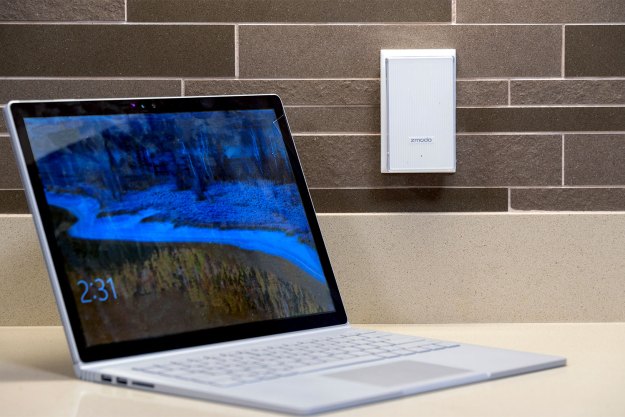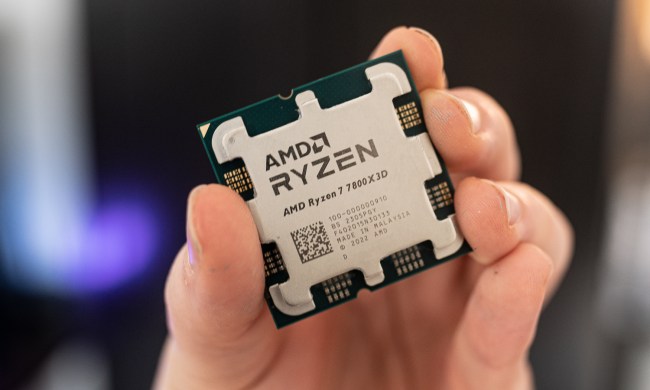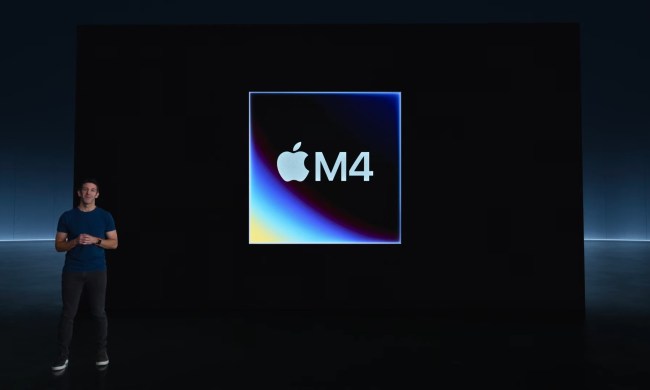
“Zmodo’s Beam Alert is a unique, grow-as-you-go home security system that also kills Wi-Fi dead zones.”
- Easy to install and configure
- Highly expandable and configurable
- Flexible alert scheduling
- Extends Wi-Fi signal with minimal effort
- Long boot time
- Pricy accessory ecosystem
While devices that extend your Wi-Fi signal to eliminate dead zones in your home or office abound, you won’t find many that double as home security hubs. But that’s exactly what you get with Zmodo’s $49.95 Beam Alert. By itself, Beam Alert is just one more way to make your home network and Internet connection accessible in the back bedroom or upstairs, but with the addition of the company’s multiple accessories—door and window sensors, motion and smoke detectors, video cameras, gas and carbon monoxide detectors, and alarms—you can turn your wireless network and smartphone into a home security system.
If all you need is simple Wi-Fi extension, it’s easy to find less-expensive solutions, such as Netgear’s AC750 Wi-Fi Range Extender. And yes, there are devices, such as D-Link’s Wi-Fi Audio Extender, that do more than merely extend your wireless signal. There’s also several wireless security solutions, including Stack Lights BeOn bulbs and the iSmartAlarm. However, Beam Alert is the only combined Wi-Fi extender and security system we know of. When you think about it, though, the matchup makes a lot of sense.
Plug and Protect
Out of the box the Beam Alert is an off-white plastic block measuring 1.2 by 2.4 by 3.7 inches, which you plug in to any wall AC outlet. Once configured, it extends your Wi-Fi signal up to 656 feet. It weighs about a quarter of a pound and requires a Type B, 3-prong socket electrical socket. Until you download the app and connect to it with your iOS or Android smartphone and configure it, though, it does nothing but sit there and blink.
On the outside, aside from a status light on the front and a reset button on the side, there’s not much to it. In that regard it’s not different from D-Link’s Wi-Fi DAP, a simple Wi-Fi signal extender. The Zmodo’s packaging includes a small Getting Started booklet that, unless you have very good eyes, you’ll need magnification to read. Otherwise, downloading the app and connecting to the Beam Alert is straightforward.
Connecting remote devices and increasing home security
The Beam Alert does a reasonable job of boosting a wireless signal. What we didn’t care for was how long it takes the device to boot up and connect to a Wi-Fi network. Zmodo told us that it took about 3 minutes to boot, which is just long enough for the impatient among us to start wondering if it’s not working.
The Beam notifies you by text messages or email when a door or window opens or closes.
Once it’s up and connected to your network, it’s possible to connect various devices (computers, smartphones, tablets, smart TVs, and so on) to it just as if it’s a wireless router, although it doesn’t support Wi-Fi Protected Setup for one-touch connectivity.
As mentioned, the Beam Alert supports several kinds of sensors. Zmodo sent us a two-pack of devices that detect the opening and closing of doors and windows. They connect and configure with the same app used to configure the Beam itself, and once they’re installed, the Beam notifies you by text messages and/or email when a door or window opens or closes. The Beam can configured to “buzz” — it’s actually a shrill beep — whenever a sensor’s alarm is tripped.
All of this is controlled from the Zmodo app, essentially turning your mobile device into the center of your home security system.
Zmodo app and system performance
In addition to connecting your sensors to the Beam, the Zmodo app allows you to turn sensors on and off, setup activation scheduling, name and rename sensors and detectors, and more. Currently, notifications are saved for 24 hours on Zmodo servers — if you buy one of the company’s surveillance cameras, different storage options are available — but as we wrote this the company was preparing to roll out a subscription cloud service for saving your messages and videos. Pricing and service types were not yet available.
For the most part, the system worked well, though at one point we did have to reset the Beam and reconfigure it, which was much easier the second time around. But waiting for it to boot, and then reboot as part of a system diagnostic, was annoying. Aside from that, the Wi-Fi extender and home security features worked well, though an unexpected encounter with a cat unplugged the unit. A feature telling you when the system is offline would be helpful.
Warranty information
The Zmodo Beam Alert and accessories warranty provides replacement if they stop working during the first year of ownership under normal use.
Our Take
The Zmodo Beam Alert is a capable Wi-Fi extender and a reasonably reliable, customizable-as-you-go security system, although it is dependent on your Internet service – but most low-cost security solutions have failure points. During our time with it, we found it easy enough to setup and use, and once in place, everything worked as expected. Depending on the size of your home, buying enough sensors for all of your doors and windows, as well as some of the other sensors and detectors, could get expensive
Is there a better alternative?
As mentioned, we don’t know of another product like this, one that extends wireless signals and acts as a security system hub. It really is an innovative product if you need both solutions, and to make sure that all of your doors and windows are protected, you just might need your wireless network signal extended. There are routers that work as home hubs, like the Securifi Almond 3— which we think is great — but they’re more expensive.
How long will it last?
The Beam Alert itself, the app, and the servers behind it are under constant updating and development. Upgrades like the upcoming subscription cloud service lead us to assume that Zmodo will continue to support it, and is in this for the long hall. The Beam Alert itself and the sensors seem durable, and the sensors have replaceable batteries.
Should you buy it?
Yes. The Beam Alert worked well during our testing, as both a Wi-Fi extender and as a hub for connecting Zmodo’s home security accessories. If you need to clear up Wi-Fi dead spots in your home, we say go for it. While there are plenty of more secure home security alternatives available, such as monthly security services, this one is relatively inexpensive to get started, and you can add components as you go. It’s also easy to take with you when you move, which makes it great for renters.










